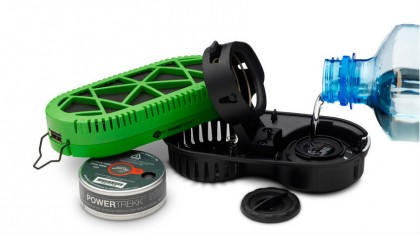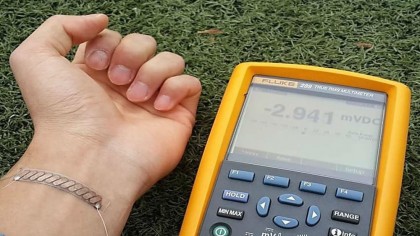Pumping ion: Could our bodies power our phones?
Pouring your blood, sweat and tears into your phone battery

The kinetic Ampy, above, is covered in a sweat-proof coating, to protect its systems. That would be a terrible idea for some more conceptual chargers, given that they would be using sweat and other bodily fluids as their energy source.
In 2014 Dr Wenzhao Jia, of the University of California, created a prototype charging patch. It uses materials contained in sweat to generate up to 70 microwatts per square cm of skin. Sadly, it was so small that it only produced 4 microwatts of power meaning that 3,000 of them would be needed to power the lowest powered 10 milliwatt LED.
Dr Harry Zervos is skeptical of the state of the technology. "There are many research-level projects, but no commercial momentum to date. Again, the amount of power is too low in most cases, especially from something as power hungry as a mobile phone. However, as skin patches with much lower power consumption begin to see market traction, this becomes a very interesting proposition."
The PowerTrekk, shown below, isn't quite a sweat-powered charger, but it's a similar concept, as it contains a fuel cell that runs on water and salt. It's designed for mobile charging in situations where you have absolutely no access to power lines - and where other methods like solar charging aren't effective, like dark or wintery climates.

You simply pour water (or any water-based liquid, like urine) into the container, add a small salt block, and it pumps out enough electricity in two hours to charge a smartphone twice. It's on sale for €99 (around $115) - though the salt pucks cost around €3 / $5 each.
Power from your blood
Your blood is ridiculously energetic, with all that glucose floating about, meaning it's just perfect for implanted fuel cells.
However, you can't simply harvest the blood's heat - you have to access the same chemical energy we use ourselves. "There is research in converting chemical energy to electricity to power implantable devices," says Tom Snyder, "which is important since you can't achieve the thermal temperature differential to generate high levels of power inside the body."
Get daily insight, inspiration and deals in your inbox
Sign up for breaking news, reviews, opinion, top tech deals, and more.
EFCs (enzymatic biofuel cells) are devices that extract electricity from a fuel source by using enzymes to catalyze an oxidation reaction. Implanted ones would use the sugar in your blood as the fuel source.
They've been tested internally in rats, rabbits, lobsters and cockroaches, and produced a good 40 microwatts of power. Of course, they have huge problems - they're invasive as hell for one thing - but they'll be ideal for bionic implants because they're cheap to make and practically free to fuel.
And don't worry that they'll steal power from your body, in some hideous Matrix-style dystopia - unless you're diabetic, your body's insulin system automatically adjusts to low blood sugar levels. It might be an exceptionally easy way to lose weight!
Heat into phone juice
Whilst piezoelectrics generate power from deformation, thermoelectrics generate it (you guessed) from heat - specifically, the heat differences between the inside of clothing and the outside. The voltage generated is directly proportional to the heat gradient across them - so extreme weather is ideal for this.
Tom Snyder is highly optimistic about these. "For wearables, the potential for thermoelectrics in particular is much higher and maturity of technology is further along than the other technologies you mention."
An armband form-factor vigilant EKG monitor (an armband which measures your vital signs) that was completely powered by body heat has been demonstrated at the university level by ASSIST, so the systems are feasible.

Similarly, researchers at KAIST (the Korean Advanced Institute of Science and Technology) have created a device that harvests excess body heat to generate electricity. At the moment it only generates around 40 milliwatts. Given that, it's likely to only be used for low-powered devices, like smart watches and smart clothing.
All for one...
Of course, not all of these devices have to work alone - a combination of techniques could mean higher outputs and allow for redundancy when some sources aren't available. After all, it would be so annoying to not be able to charge your phone from your EFC because you couldn't find a vein...
Dr Harry Zervos has recent experience of this 'multi-mode harvesting'. "I was in Korea earlier this month where one professor told me they had achieved around 5mW harvesting from a combined electrodynamic/piezoelectric/triboelectric unit the size of an AA battery".
"That's still too big, but if they can get that level of harvesting from something AAA-sized or smaller, then one can see the beginning of uptake in the consumer electronics space."
To clarify, that's a device the size of an AA battery that gathers power from magnetic induction, cloth compression and static electricity. That's pretty impressive, but like most of this tech it needs to generate a higher wattage to be useful.
The body as wireless charger
For all mobile devices Dr Harry Zervos thinks wireless charging is an important alternative solution to better batteries and body-derived power sources. "There is still a power problem," he tells us, "so integrating wireless charging, both in devices but also in a broader infrastructure, has been the most prominent commercial method to counter this recently."

And wireless charging is already commonplace; heck, even IKEA sell a range of furniture with built-in wireless chargers. It's likely that wireless chargers will be a useful bridging technology for implanted devices, like pacemakers and more futuristic bionic augmentations like implanted phones, which couldn't have large batteries or charging sockets.
Of course, for our purposes, that wireless charger might be drawing on your body's power to charge your phone. Or whatever we have instead of phones by then…